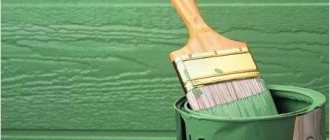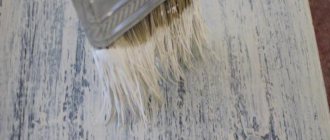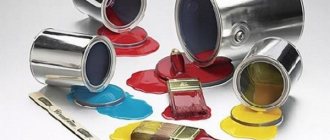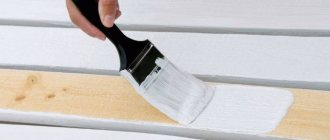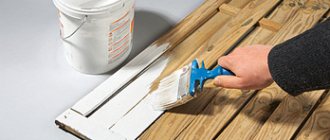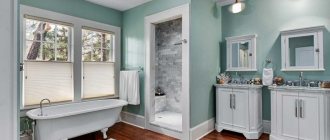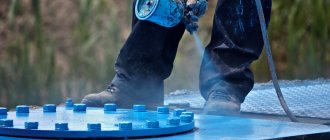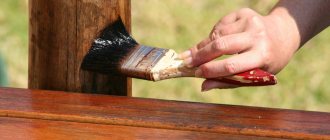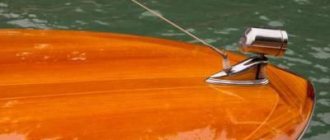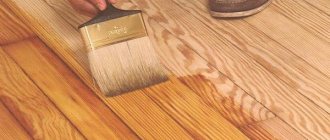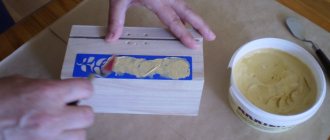SHARE ON SOCIAL NETWORKS
FacebookTwitterOkGoogle+PinterestVk
From this article you can learn all the advantages and nuances of such a finishing material as odorless wood paint for interior work. Let us consider in detail the main types of compositions intended for finishing living rooms, their advantages and properties. The text also provides information about popular manufacturers in this category and average prices for their products.
When painting surfaces in a residential area, you should choose only environmentally friendly, odorless dyes
Odorless wood paint for interior work: specifics of the material
The painting method is often used to decorate interior spaces. Living rooms put forward special requirements regarding the composition of dyes applied to surfaces. Since people spend a lot of time in such rooms, it is important that the finishing materials dry quickly, have no odor and are environmentally friendly.
Thanks to a wide selection of compositions and a range of shades of dyes, you can realize any idea when painting a wooden surface
Fortunately, there are a lot of modern materials on the market that have the necessary properties. Thanks to them, painting work inside the house is carried out safely, comfortably and without toxic fumes.
What colors to paint the walls in the house: main selection criteria
It may seem that choosing a paint for residential premises is very simple. In fact, a high-quality result depends on many factors, including increased requirements for the characteristics of the composition and the operating conditions of the room.
When choosing the appropriate type of dye for interior painting work, you should pay attention to the following parameters:
- durability of the coating;
- degree of resistance to moisture;
- environmental cleanliness;
- simplicity and accessibility of operation, as well as procedures for caring for painted surfaces;
- level of resistance to mechanical loads (abrasion, damage);
- Fire safety;
- covering ability of the material;
- decorative properties.
If it is necessary to paint a wooden surface in bright shades, you should pay attention to the durability of the performance characteristics of the dye
The affordable price of quick-drying, odorless wood paint is also one of the criteria that most buyers pay attention to. To choose the best option for finishing material, you need to get a general idea of all types of compositions, their features and properties, as well as advantages and disadvantages.
Note! Many manufacturers focus on the ease of working with this or that dye. For example, some dyes are credited with the function of completely transforming rust. But you should not neglect the requirements for the technology of working with the composition and material of the base. This especially applies to the stage of surface preparation for painting. Therefore, it is recommended to thoroughly clean the base and perform other work, regardless of the properties declared by the manufacturer.
Features of choosing wood paint for interior work
While in the store, first of all you need to pay attention not to the characteristics declared by the manufacturer, but to the composition of the dye.
Popular brands offer lines not only for painting wooden home furnishings, but also protective equipment
Most materials include the following components:
- pigment particles that give the coating a certain shade;
- a binder that acts as a base element and forms a film coating on the surface being treated;
- fillers that provide decorative properties, gloss level and reliability;
- additional additives that give the coating special properties.
Special properties include fire safety and the ability to dry quickly. Some types of compositions, for example, wood floor paints, are wear-resistant. Various types of compounds are used to finish internal surfaces: oil, acrylic, alkyd, etc. All of them have special properties and advantages.
To buy high-quality decorative paint for walls, you also need to take into account the operating conditions of the room:
- climatic conditions of the building (increased moisture level, presence of heating or lack thereof);
Odorless wood dyes are available not only in cans and buckets, but also in spray cans, which allows you to quickly and conveniently paint small surfaces
- what type of wood the surface is made of (species, base texture);
- what is the likelihood of a fire occurring in the building (the presence of flammable objects and materials, as well as fire sources, their distance and the degree to which fire safety requirements are maintained);
- whether there is an old coating on the surface (in some cases, it may be necessary to first remove the paint from the wall or you will have to select the appropriate type of paint).
Also, the dye is selected taking into account expectations regarding decorative qualities, for example, the desired effect, texture, shade. In the palette of paints for walls in an apartment, you can choose any color, and the coating can be matte, glossy, semi-matte or structural.
How to remove paint from walls before painting: instructions
Before the painting procedure, it is recommended to remove the old paint layer from the surface. This requirement especially applies to oil compositions, which are completely incompatible with other types of coatings.
Old paint from a wall can be effectively removed with a small spatula.
There are several ways to remove oil paint from a wall:
- Mechanical.
- Chemical.
- Temperature.
Important! It is not recommended to use the heat method for removing coatings on wooden surfaces. Not every type of wood can withstand this type of impact. The exception is beech and oak, they are endowed with high strength characteristics.
There is no universal effective method for all cases, so experts recommend using all stages of work sequentially. To begin with, you can try to remove the paint layer using a regular spatula. If the previous painting was carried out in compliance with all technological requirements, and a primer was applied to the surface, then the mechanical method will be quite sufficient. Finally, you just need to refine the base using medium-grain sandpaper.
To remove several layers of old paint from a wooden surface, you can use a hair dryer and a spatula, but you should pay attention to the type of wood so as not to deform it
If a spatula does not help, in such cases you can use a sanding machine, which will significantly reduce the layer of old coating. The surface is processed until the wood texture begins to appear. If this does not help, the wall is treated with a solvent or a special remover. The product is selected according to the type of dye that needs to be removed. Only in this case can you count on effectiveness. At the end, the surface is cleaned with sandpaper.
Manufacturers
When choosing the really best paint for wood, pay attention to its packaging, components, and expiration date.
Good manufacturers produce their products in sealed containers, convenient for long-term storage. They also label the product correctly, indicating on the packaging all the information necessary for the consumer.
Among the already established manufacturers of wood painting products:
- Tikkurila is a Finnish brand that specializes in the production of all kinds of finishing materials. Although its products have a fairly high price compared to others, it is fully compensated by quality. Painting wooden lining, ceilings, floors, furniture, windows and doors with materials from this manufacturer will give them an excellent appearance and protection from environmental influences;
- Alpina - products are manufactured in Germany, have an attractive price and good quality. The manufacturer produces materials for both exterior finishing of wooden buildings and interior work. The advantage is a wide color palette;
- Neomid is a domestic manufacturer that can easily compete with foreign companies. Neomid produces interior paint for wood with increased fire-resistant properties;
- Belinka is a medium-priced, high-quality product from Slovenia. It has a wide range of finishing materials for wood, including protection against fungus, moisture, sun, and chemicals. This product is easy to work with, as it has an optimal texture and does not spread on the surface.
Now you know that when choosing what paint to paint a wooden house inside or outside, you need to pay attention to the main characteristics and positive properties of the available range and purchase what is best suited for your case and budget. However, remember that good and correctly selected finishing materials will help keep the treated surface intact and neat for a long time and will allow you to make repairs much less frequently
For lovers of natural compositions, we recommend that you get acquainted with such a material as paint with wax for walls. This may be what you need. You may also be interested in learning how to paint the steps of a wooden staircase.
How to choose odorless wood paint for its intended purpose
Paints differ from each other not only in the type of base (binder), but also in purpose. The healthy microclimate in the room and whether the coating can live up to expectations depends on how correct the choice is.
To preserve the natural texture, you cannot do without using glaze paints for wood for interior work. These transparent compounds will highlight the natural beauty of the wood pattern. Environmentally friendly water-based dyes will help give the desired shade to surfaces.
To make the painted surface shine, you can use a special varnish, which will additionally protect the wood from mechanical stress.
This type of composition can be used to process the following objects:
- baseboards;
- floors;
- panels;
- doors;
- windows and frames;
- slopes;
- furniture.
Recommendations for using paints in different rooms
If the building is entirely made of timber and it is not possible to cover the surfaces with another finishing material, it is better to use acrylic paint for wood for interior work. This type of coating is able to visually mask unevenness and errors on the walls, as well as provide high throughput. By allowing air to flow into the wood, living spaces remain comfortable and dry. It is allowed to use acrylic paint to finish imitation timber.
For kitchen furniture and children's rooms, it is better to use dyes marked “Eco Label”, which confirms the environmental friendliness of the selected composition
For children's rooms, it is better to choose easily washable acrylic-based paint, which can be used to completely paint the walls or create a design using a stencil. The composition must be checked very carefully, because the presence of harmful substances will negatively affect the child’s health. Therefore, you should carefully approach the issue of what colors to paint on the walls of children's rooms.
Helpful advice! The Eco Label marks environmentally friendly products. Dyes with this label can be safely used to decorate a children's room.
Acrylic and latex compounds are suitable for bathrooms and kitchens, as is rubber paint for wood floors. The main thing is that they contain antifungal components. For kitchens, it is preferable to choose mixtures that form a coating that is easy to maintain. It is desirable that greasy stains and dirt are easily washed off from its surface.
Rooms such as the hallway and corridor are characterized by high traffic. Therefore, all surfaces are subject to severe mechanical stress. For their finishing, it is recommended to use acrylic-latex compounds with abrasion resistance.
To paint products, walls and floors in the bathroom, you can use acrylic and latex compounds that are resistant to high humidity and abrasion
Utility areas in homes also need maintenance. As a finishing material, it is better to use budget category dyes, for example, vinyl or acrylic wood paints for interior work. In areas where laundry is washed or dried, the same formulations are used as in kitchens and bathrooms.
Related article:
Wood paint for exterior use: a brief overview of dyes
Features of application, main types of compositions, their properties, strengths and weaknesses. Criteria for selecting quality dyes.
Selection of paints and varnishes
Paintwork materials are classified according to the following criteria:
- By composition (water and organic based);
- By protective effect (against organic and chemical substances, mechanical influences, changes in humidity and temperature);
- By method of use (internal, external, combined);
- By type (impregnations, paints, stains, varnishes).
1. Paints. Can be used to process new and old doors. There are no difficulties in choosing, but due to incompetence people choose the wrong material. Paint and varnish compositions can be transparent or opaque. The first compositions include certain pigments that exhibit the woody structure. But opaque coatings consisting of organic solvents (oil, alkyd and other types) are often used.
The most popular is alkyd enamel, the cost of which is affordable. This coating is highly durable and has a wide range of shades. But the enamel smells bad, its unpleasant odor remains for 2 days, so they work with it outside, first removing the canvas from the hinges or vacating the room. An alternative solution is acrylic enamel, which also has many colors but does not have a toxic odor. Dried paint does not have much strength, so it is additionally treated with acrylic varnish to protect it from mechanical stress.
Rice. 2. Paint on wood
A more durable coating for wood doors is nitro paint, which has optimal strength. The composition is toxic and sometimes leads to allergic reactions, so you need to wear protective equipment when working with it. If an old surface is treated with nitro paint, the panel is prepared and sanded in advance to a light shade.
2. Varnishes. They are traditional coatings that add shine to wood and protect its surface. Typically, varnish is used to coat doors in rooms with high humidity (baths and saunas).
There are many different varnishes:
- Acrylic. The material is resistant to negative influences, humidity and ultraviolet radiation. There are matte and glossy finishes without a toxic odor.
- Nitrocellulose. Wooden doors can be treated with varnish. The coating is not suitable for treating bathrooms and saunas, as it has insufficient strength and cracks quickly.
- Water based varnish. It has no unpleasant odor. Due to different additives, the properties of the material may differ.
- Polyurethane. The varnish has high strength and adhesion to wood, and comes in matte, semi-gloss and glossy. In addition to wood, polyurethane varnishes can be applied to parquet, veneer, and countertops.
- Oil varnish. There is no pungent odor. The composition contains a lot of fatty resins, so the old coating is removed from the door in advance. It is better to apply with a brush due to the thick consistency.
- Polyester. The composition has a pungent odor, is highly durable, but is toxic, so it is suitable for treating street doors.
It is better to paint interior doors with acrylic or polyurethane coating, and resistant materials are suitable for external work or rooms with high humidity.
Rice. 3. Varnish on wood
3. Stains. The purpose of such compositions is to tint the wood and provide temporary protection from negative influences. But it requires constant updating of the layer that emphasizes the wood structure.
There are several options:
- With a varnish base (azure). The composition reduces the duration of work, but aesthetics are difficult to achieve, so a single-color surface can be obtained by spraying with a spray gun;
- With oils. Must be diluted with solvent before use;
- With water. It takes longer to dry, but there is no toxic odor. The composition penetrates deeply, giving a more saturated shade and a clear pattern that looks beautiful;
- Alcohol based. It dries quickly, but is more expensive and has a strong odor.
Fig.4. Wood stain for a wooden door
To protect wood from fungus, moisture and dirt, oil wax is used, which penetrates deeply into the surface. The coating adds strength and shine.
Features of acrylic decorative paint for interior decoration of walls, ceilings and floors
Acrylic compositions belong to the category of water-dispersion paints for walls and ceilings, as well as floors. For each type of surface, a certain type of coating is selected, because walls and floors are subject to greater loads than the ceiling. Most often, these dyes are based on ethyl, methyl and butyl polyacrylates. In some cases, manufacturers use copolymers of these components, which are responsible for film formation.
For the hallway and corridor it is worth using dyes that have a high level of resistance to mechanical stress
Acrylic paints on wood for floors, ceilings and walls have a similar composition:
- aqueous solvent – 30-40%;
- coloring particles - from 4 to 20% (pigments can be represented by zinc white or titanium dioxide);
- fillers - from 30 to 40% (cellulose particles, talc, chalk, crushed marble chips);
- substances in the form of ethers, alcohols, alkalis – 2-4%;
- antiseptic components;
- preservatives and plasticizers.
Compositions in this category are divided directly into acrylic paints for wood floors and styrene-acrylic dispersions. They are elastic, vapor permeable and resistant to moisture.
Interesting fact! Acrylic-based latex paint can withstand up to 5,000 washing procedures. At the same time, its external attractiveness and brightness of color are preserved.
Some of the advantages of acrylic wood paints for floors are elasticity, vapor permeability and resistance to moisture.
Features of Tikkuril paints for wood for interior work
The manufacturer Tikkurila produces luxury finishing materials, so their cost cannot be called low. Therefore, some consumers are wondering whether it is worth purchasing such paints or whether it is better to choose something else.
The most popular dye in this range. This type of composition has excellent qualities, it is very easy to use, and the result of coloring is a high-quality and beautiful coating. An undoubted advantage is the absence of caustic substances, which other mixtures cannot boast of. During the painting process and during further operation of the premises, the possibility of harm to human health is eliminated.
“Harmony” paint is used mainly for walls and ceilings. The composition has three packaging options, and its price is in the range of 660-7250 rubles. (depending on the color and volume in the package).
Luxury dyes from the manufacturer Tikkuril are suitable for finishing wooden walls and ceilings in living rooms
Another option for floor dye is “Betolux”. Suitable for both concrete and wooden surfaces. This type of coating has a specialized purpose specifically for flooring, so the manufacturer has endowed it with resistance to heavy mechanical loads. About 90% of paint and varnish products on the market are significantly inferior to this composition. Despite the high technical characteristics, the coating is not only practical, but also aesthetic.
The price of Tikkurila floor paint for wood is in the range of 750-7590 rubles. At the same time, the coating perfectly repels dirt. It can be used for finishing floors in children's rooms, because the composition is completely safe and environmentally friendly.
Specifics of alkyd paints for wood for interior work
Unlike acrylic compositions, varnishes serve as the basis for creating alkyd paints. They are a combination of thick resin, glycerin, rosin and vegetable oils. The composition may contain other components that give the dye special properties. Alkyd enamel takes about 2-3 days to dry.
Many wood dyes not only mask unevenness, but also emphasize the beauty and texture of the log house.
Advantages of alkyd coatings:
- long service life;
- water resistance;
- affordable price;
- resistance to mechanical stress;
- protection of wood from putrefactive processes.
All these properties make alkyd paint the optimal finishing material for flooring.
Helpful advice! If the alkyd-based dye has thickened, it is better to use a special-purpose organic-based solvent to dilute the mixture. White Spirit is suitable for these purposes.
Due to the fact that wood floor paint is moisture resistant, the surface can be frequently wet cleaned with detergent
Alkyd enamel Euro Pesto 30 from the manufacturer Tikkuril is intended for rooms where coatings are subject to high loads, for example, frequent washing procedures. The dye is suitable for wood and metal. It can even be used for finishing radiators. The price of the composition is in the range of 550-4590 rubles.
Features of odorless paints for wood furniture
Wood is most often used to make furniture. Over time, during use, the paint layer on the material wears off, and scratches, chips and cracks form on the surface. But this is not a reason to throw away your favorite chair or cabinet. Updating the paint layer completely solves this problem, and also allows you to update the design of the item and the interior of the room as a whole.
For such purposes, the following types of dyes are usually used:
- acrylic;
- latex-based water-based compositions;
- silicone water-based.
The most popular of them are acrylic compositions.
Latex-based water-based dyes are one of the most popular compositions for painting natural wood furniture
Possibilities and properties of acrylic paints for wood furniture
The increased popularity of acrylic-based dyes is due to several factors. First of all, it is safety, short drying period and fire safety. The coating can minimize the damage that a room may suffer as a result of an accidental fire. In addition, the paint has good adhesive properties and fits perfectly on wood surfaces or materials made on its basis.
It is allowed to use acrylic paints for furniture made from the following materials:
- OSB;
- plywood;
- particle boards;
- MDF.
If necessary, acrylic paints for wooden furniture can be tinted in different shades
The base color of acrylic dyes is white. Using a color that can be purchased or added in a store, a light base can be given any shade. Most quality dyes contain antiseptic substances in their composition. This eliminates the possibility of damage to the wood by fungi and mold, resulting in an extended product life.
Helpful advice! If you purchase acrylic paint with water- and dirt-repellent additives, after using it you will have to clean furniture made of wood much less frequently.
Distinctive properties
In wood house construction, acrylic paints have replaced oil-based paints due to their high performance qualities, which make it possible to reliably protect wood structures for a long time and at the same time ensure a beautiful appearance of buildings. Its main distinguishing feature for acrylic paint will be its water solubility - that is, until it dries, it can easily be removed with water. when the composition dries, it will create a high-strength layer on the surface of the material that will not be washed off with water. acrylic types of dyes have an unusual composition, due to which the painted surfaces will have a bright color that will not change over time, and a durable coating that is not prone to cracking.
After drying, the acrylic layer will continue to retain elasticity, due to which temperature changes or air humidity will not be dangerous for it. It is for this reason that such paint and varnish compositions are widely used for wood processing both inside and outside the building. Also, acrylic compositions differ in the relative speed of drying, but this indicator depends on the quality of preparation of the base, as well as on the type of wood and environmental conditions. The maximum period of final drying is limited to 72-96 hours.
Features of water-based wall paints: how much the compositions cost, their types
Water-based dyes have a liquid consistency. Due to this, the protective coating is reliable, because the composition is able to penetrate deep into the wood. The mixture is based on water, coloring pigments and binders. In addition, the composition contains fillers that ensure quick drying of the paint, moisture resistance of the coating, etc.
The composition and consistency of water-based wall paint can be adjusted for ease of application using water
To dilute the dye, an organic-based solvent is used. White Spirit is optimal for these purposes. The coating dries 2-6 hours after application. There are several types of emulsions on sale, so it is recommended to carefully study the information on the packaging.
